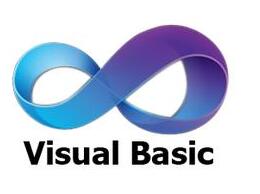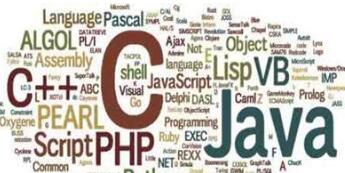Visual Basic is a structured, modular, object-oriented, visual programming language that includes an event-driven mechanism that assists the development environment. From any standard, VB is the most used language in the world – whether it is the developer who praises VB or the number of developers who complain about VB.
It is derived from the BASIC programming language. VB has a graphical user interface (GUI) and a rapid application development (RAD) system that can easily connect to databases using DAO, RDO, ADO, or easily create ActiveX controls. Programmers can easily build an application quickly using the components provided by VB.
Vb language features
1. VB is a visual, object-oriented and event-driven structured high-level programming language;
2, can be used to develop various applications in the Windows environment;
3. In the Visual Basic environment, use event-driven programming mechanism, novel and easy-to-use visual design tools.

Java is an object-oriented programming language. It not only absorbs the various advantages of the C++ language, but also eliminates the concepts of multiple inheritance and pointers that are difficult to understand in C++. Therefore, the Java language is powerful and easy to use. As a representative of static object-oriented programming languages, the Java language implements object-oriented theory very well, allowing programmers to perform complex programming in an elegant way.
Java is characterized by simplicity, object-oriented, distributed, robustness, security, platform independence and portability, multi-threading, and dynamics. Java can write desktop applications, web applications, distributed systems, and embedded system applications.
Java language features
1, simplicity
Java seems to be designed much like C++, but in order to make the language small and easy to get familiar with, designers have removed many of the features available in the C++ language, which are rarely used by general programmers. For example, Java does not support go to statements, instead providing break and continue statements and exception handling. Java also eliminates the C++ operator overload and multiple inheritance features, and does not use the main file, eliminating the preprocessor. Because Java has no structure, arrays and strings are objects, so no pointers are needed. Java can automatically handle object references and indirect references, enabling automatic garbage collection, so that users do not have to worry about storage management issues, and spend more time and effort on R&D.
2, object-oriented
Java is an object-oriented language. For programmers, this means paying attention to the data in question and the method of manipulating the data, rather than strictly thinking about the process. In an object-oriented system, a class is a collection of methods of data and operational data. Data and methods together describe the state and behavior of an object. Each object is a wrapper around its state and behavior. Classes are arranged according to a certain system and hierarchy, so that subclasses can inherit behavior from superclasses. There is a root class in this class hierarchy, which is a class with general behavior. Java programs are organized by classes.
Java also includes an extended collection of classes that make up various packages that users can use in their own programs. For example, Java provides classes that generate graphical user interface components (java.awt packages), where awt is an abbreviation for the abstract windowing toolkit, classes that handle input and output (java.io packages), and classes that support network functions. (java.net package).
3. Distribution
Java is designed to support applications on the web, it is a distributed language. Java supports both various levels of network connectivity, and the Socket class supports reliable streaming network connections, so users can generate distributed clients and servers.
The network becomes a distributed delivery vehicle for software applications. Java programs can be run everywhere as long as they are written once.
4, compile and explain
The Java compiler generates byte-code instead of the usual machine code. Java bytecode provides an architecturally neutral object file format designed to efficiently transfer programs to multiple platforms. Java programs can run on any system that implements a Java interpreter and a run-time system.
In an interpretive environment, the standard "link" phase of program development has largely disappeared. If Java has a link phase, it is just a process of putting new classes into the environment. It is an incremental, lightweight process. Therefore, Java supports rapid prototyping and easy experimentation, which will lead to rapid program development. This is a sophisticated development process that contrasts with traditional, time-consuming "compilation, linking, and testing."
5, robustness
Java was originally used as a language for writing consumer home electronics software, so it was designed to write highly reliable and robust software. Java eliminates some programming errors, making it easy to write reliable software.
Java is a strongly typed language that allows extensions to check for potential type mismatch issues at compile time. Java requires explicit method declarations, which do not support C-style implicit declarations. These strict requirements ensure that the compiler can catch call errors, which leads to more reliable programs.
One of the most important enhancements in reliability is the Java storage model. Java does not support pointers, it eliminates the possibility of overwriting storage and corrupting data. Similarly, Java's automatic "garbage collection" prevents storage leaks and other harmful errors related to dynamic storage allocation and deallocation. The Java interpreter also performs a number of runtime checks, such as verifying that all array and string accesses are within bounds.
Exception handling is another feature in Java that makes programs more robust. An exception is a signal that appears to be similar to an abnormal exception condition. Using the try/catch/finally statement, the programmer can find the error handling code, which simplifies the task of error handling and recovery.
6, security
Java's storage allocation model is one of the main ways it protects against malicious code. Java has no pointers, so programmers can't get hidden insiders and fake pointers to point to memory. More importantly, the Java compiler does not handle storage scheduling decisions, so the programmer cannot guess the actual storage arrangement of the class by looking at the declaration. Stored references in compiled Java code are determined by the Java interpreter at the runtime to determine the actual storage address.
Java Runtime uses a bytecode verification process to ensure that code loaded onto the network does not violate any Java language restrictions. This security mechanism section includes how the classes are loaded from the web. For example, a loaded class is placed in a separate namespace instead of a local class, preventing malicious applets from replacing standard Java classes with their own versions.
7, portability
Java makes language declarations independent of the implementation aspects. For example, Java explicitly states the size of each primitive data type and its arithmetic behavior (these data types are described by Java syntax).
The Java environment itself is portable to new hardware platforms and operating systems. The Java compiler is also written in Java, while the Java runtime is written in ANSIC.
8, high performance
Java is a language that is compiled and interpreted first, so it is not as fast as a fully compiled language. But in some cases performance is very important. To support these situations, Java designers have created "timely" compilers that translate Java bytecode into machine code for a particular CPU (central processing unit) at runtime. It is to achieve full compilation.
The Java bytecode format is designed with these "just-in-time" compilers in mind, so the process of generating machine code is fairly straightforward, and it produces fairly good code.
9, multi-cue
Java is a multi-threaded language that provides support for multi-threaded execution (also known as a lightweight process), handles different tasks, and makes clever programming easy. Java's lang package provides a Thread class that supports methods for starting clues, running clues, stopping clues, and checking the status of clues.
Java's clue support also includes a set of synchronization primitives. These primitives are based on supervisory procedures and conditional variables, a widely used synchronization scheme developed by CARHaore. With the keyword synchronized, the programmer can show that some methods cannot run concurrently in a class. These methods are under the control of the supervisory process, ensuring that the variables are maintained in a consistent state.
10, dynamic
The Java language is designed to adapt to changing environments, and it is a dynamic language. For example, classes in Java are loaded as needed, and some are even acquired over the network.

VB has a visual user development interface that starts with a simple language. Some features in C++ and Java do not appear in VB. Some features like type and declaration checking at compile time are turned off by default. So it will cause some similar "undefined type" errors to occur.
Visual Basic is a structured, modular, object-oriented, visual programming language that includes an event-driven mechanism that assists the development environment.
Java is an object-oriented programming language that can write cross-platform applications. Java technology delivers exceptional versatility, efficiency, platform portability and security for PCs, data centers, game consoles, scientific supercomputers, mobile phones and the Internet, as well as the world's largest developer community.
Vb: A popular desktop development technology, developed by Microsoft (Visual Basic) is a tool, the language is Basic. Basic is a big tool for Bill Gates to get rich. It is mainly used for desktop programs, C/S systems. Later, because of the impact of Delphi, I was forced to occupy a part of the market and now have .NET. Basically, the elimination of VB is a matter of time!
By the way, .NET .NET: Microsoft Visual .NET, Microsoft is used to compete against Java's new products, the main market is enterprise-level development, and Sun's java ee competition is particularly strong.

The biggest difference between Home Theater Projector and ordinary business projectors is the resolution and ease of use. Most of the mainstream Home Theater Projectors have a resolution of 1080P Full HD, and are equipped with an intelligent system, which makes the projector more convenient to use. Home Theater Projector mainly pursues brightness, color, and contrast, which can bring users an immersive and realistic experience.
Features
1. Large screen: The size of traditional LCD TVs is mostly between 40-70 inches, while the Home Theater Projector can easily project 100-150 inches of screen content.2. Diverse uses: Home Theater Projector will be equipped with intelligent systems, which contain a large number of film sources. In addition, the projector can also be connected to different devices through different interfaces, such as game consoles, computers, U disks, etc. Only one machine can realize online drama, listening to songs, games, office and other functions.
3. Diffuse reflection eye protection: Home Theater Projector uses the principle of diffuse reflection to form images, which is less harmful to the eyes than the LCD screen.
4. Diverse usage scenarios: Home Theater Projector can adapt to different sizes of bedrooms, living rooms and even dedicated audio-visual room scenes due to its different brightness.
According to the increase of people's needs, the forms of Home Theater Projector are also becoming more and more diverse. In the past, people's impression of Home Theater Projector was mostly a square box placed on a cabinet or suspended from the ceiling, but there are already portable projectors that take into account both the sense of use and the size. In addition to portable micro-projectors, larger home laser TVs are also developing rapidly. Many users have abandoned traditional LCD TVs and opted for home projectors when decorating. It can also be seen from this that Home Theater Projector has a trend of gradually replacing LCD TVs.
home theater projector bluetooth,home theater projector setup,home theater projector hd,home theater projector 1080p,home theater projector led
Shenzhen Happybate Trading Co.,LTD , https://www.happybateprojector.com
